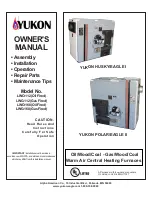
26
FI
LTE
R
FILTER
ACCESS
DOOR
RETURN
DUCT
FI
LTE
R
Figure 38
Filter Rack Mounted On
Counterflow Furnace Installation
AIR CIRCULATING BLOWER MOTOR
The air circulating blower motor bearings are permanently
lubricated. No further lubrication is required.
INDUCED DRAFT BLOWER MOTOR
The induced draft blower motor is permanently lubricated.
No further lubrication is required.
FLAME SENSOR (INTEGRATED IGNITION CONTROL)
(QUALIFIED SERVICER ONLY)
The fuel or combustion air supply can create a nearly
invisible coating on the flame sensor. This coating acts as
an insulator, causing a drop in the flame sensing signal. To
remove this coating, a qualified servicer should carefully
clean the flame sensor with emery cloth or steel wool. After
cleaning, the microamp signal should be in the range listed
in Specification Sheet.
IGNITER (QUALIFIED SERVICER ONLY)
If the igniter and the surrounding air are at about 70°F and
the igniter wires are not connected to any other electrical
components, the resistance of the igniter should not ex-
ceed 200 ohms. If it does, the igniter should be replaced.
FLUE PASSAGES (QUALIFIED SERVICER ONLY)
At the start of each heating season, inspect and if nec-
essary, clean the furnace flue passages.
CLEANING FLUE PASSAGES (QUALIFIED SERVICER
ONLY)
1. Shut off electric power and gas supply to the furnace.
2. Remove burner assembly by disconnecting the gas line
and removing the manifold brackets from the partition
panel.
3. Remove the flue from the induced draft blower and the
collector box from the partition panel.
4. The primary heat exchanger tubes can be cleaned
using a round wire brush attached to a length of high
grade stainless steel cable, such as drain cleanout
cable. Attach a variable speed reversible drill to the
other end of the spring cable. Slowly rotate the cable
with the drill and insert it into one of the primary heat
exchanger tubes. While reversing the drill, work the
cable in and out several times to obtain sufficient
cleaning. Use a large cable for the large tube, and then
repeat the operation with a small cable for the smaller
tube. Repeat for each tube.
5. When all heat exchanger tubes have been cleaned,
replace the parts in the reverse order in which they were
removed.
6. To reduce the chances of repeated fouling of the heat
exchanger, perform the steps listed in Section IX,
Startup, Adjustments, and Checks
.
BURNERS
WARNING
To prevent personal injury or death, do not
remove any internal compartment covers
or attempt any adjustment. Electrical
components are contained in both
compartments. Contact a qualified service
agent at once if an abnormal flame
appearance should develop.
Periodically during the heating season make a visual check
of the burner flames. Turn the furnace on at the thermostat.
Wait a few minutes, since any dislodged dust will alter the
normal flame appearance. Flames should be stable, quiet,
soft and blue with slightly orange tips. They should not be
yellow. They should extend directly outward from the burner
ports without curling downward, floating or lifting off the
ports.
CLEANING OF BURNERS (QUALIFIED SERVICER
ONLY)
1. Shut off electric power and gas supply to the furnace.
2. Remove the burner box front cover.
3. Remove the burner retention bracket.
4. Remove the burners.
5. Use bottle brush to clean burner insert and inside of
burner.
6. Replace burners and burner retention bracket, inspect
the burner assembly for proper seating of burners in
retention slots.
7. Reinstall the burner box front cover.
Check the burner flames for:
1. Good adjustment
2. Stable, soft and blue
3. Not curling, floating, or lifting off.
Figure 39
Burner Flame


































